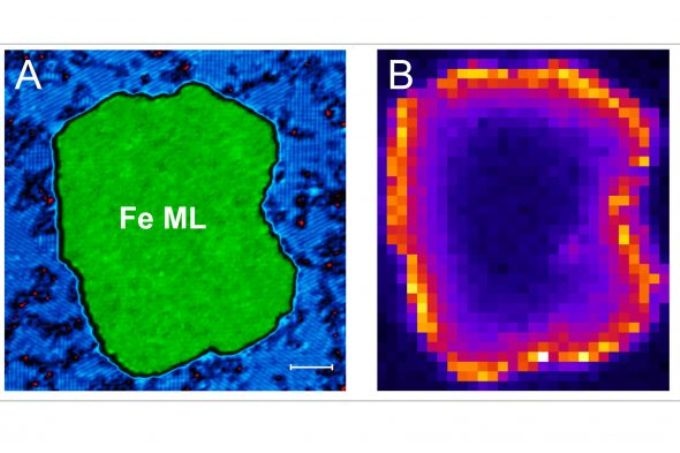Jul 30 2019
Scientists from the University of Illinois at Chicago collaborated with researchers from the University of Hamburg in Germany and successfully imaged an exotic quantum particle known as a Majorana fermion, which can be used as a basic element for future qubits and to ultimately achieve quantum computers.
 A. A monolayer of iron atoms assembled on a rhenium surface. B. Image of a Majorana fermion as a bright line along the edge of the iron using a scanning tunneling microscope. (Image credit: Dirk Morr)
A. A monolayer of iron atoms assembled on a rhenium surface. B. Image of a Majorana fermion as a bright line along the edge of the iron using a scanning tunneling microscope. (Image credit: Dirk Morr)
The study outcomes have been published in the Science Advances journal.
Over half a century ago, Gordon Moore, the former CEO of Intel, noticed that every 18 to 24 months, the number of transistors on a computer chip doubled. This trend, which is now called Moore’s Law, has continued to date, resulting in transistors that measure just a few nanometers, or one-billionth of 1 m.
At such a scale, the classical laws of physics—the foundation based on which the existing computers work—stop functioning, and they are replaced by the quantum mechanical laws. Hence, it would no longer be possible to make transistors further smaller, which has been applied in the past to increase data storage and computing speed, unless scientists can find a way to use quantum mechanics as the new basis for the next-generation computers.
Richard Feynman, one of the most prominent theoretical physicists of the 20th century, proposed this basic concept in 1982. Instead of employing classical computer bits that store information encoded in 0s and 1s, one would create “quantum bits” (or qubits) that would use the quantum mechanical laws to store any number between 0 and 1, thus exponentially increasing the computing speed and resulting in the advent of quantum computers.
Usually, when you drop your cell phone, it doesn’t erase the information on your phone. That’s because the chips on which information is stored in bits of ones and zeros are fairly stable. It takes a lot of messing around to turn a one into a zero and vice versa. In quantum computers, however, because there is an infinite number of possible states for the qubit to be in, information can get lost much more easily.
Dirk Morr, Professor of Physics, The University of Illinois at Chicago
Morr is also the corresponding author of the paper. To develop more reliable and sturdy qubits, scientists have resorted to Majorana fermions—quantum particles that exist only in pairs.
“We only need one Majorana fermion per qubit, and so we have to separate them from each other,” stated Morr.
Reliable encoding of information can be achieved by developing qubits from a pair of Majorana fermions, as long as the fermions stay sufficiently separated.
In order to realize this isolation, as well as to “image” a single Majorana fermion, it is essential to develop a “topological superconductor”—a system with the potential to conduct currents without any loss of energy and tied into a “topological knot” at the same time.
This topological knot is similar to the hole in a donut: you can deform the donut into a coffee mug without losing the hole, but if you want to destroy the hole, you have to do something pretty dramatic, such as eating the donut.
Dirk Morr, Professor of Physics, The University of Illinois at Chicago
Morr’s collaborators from the University of Hamburg built topological superconductors by placing an island of magnetic iron atoms, with a diameter of just tens of nanometers, on the surface of rhenium, a superconductor.
The group led by Morr predicted that when a scanning tunneling microscope is used, it should be feasible to image a Majorana fermion as a bright line along the edge of the island of iron atoms. This is precisely what the experimental group noticed.
“Being able to actually visualize these exotic quantum particles takes us another step closer to building robust qubits, and ultimately quantum computers,” stated Morr.
The next step will be to figure out how we can quantum engineer these Majorana qubits on quantum chips and manipulate them to obtain an exponential increase in our computing power. This will allow us to address many problems we face today, from fighting global warming and forecasting earthquakes to alleviating traffic congestion through driverless cars and creating a more reliable energy grid.
Dirk Morr, Professor of Physics, The University of Illinois at Chicago
Co-authors of the paper include Eric Mascot and Sagen Cocklin of the University of Illinois at Chicago; Alexandra Palacio-Morales, Howon Kim, and Roland Wiesendanger of the University of Hamburg; and Stephan Rachel of the University of Melbourne.
This study was supported by the European Research Council Advanced Grant ASTONISH (project no. 338802) and ADMIRE (project no. 786020); the Alexander von Humboldt Foundation; the U.S. Department of Energy, Office of Science, Basic Energy Sciences, under award no. DE-FG02-05ER46225; and the Australian Research Council (FT180100211).